If you love cut flowers but hate the high prices at the florist, why not grow your own? Growing flowers from seed are easy and rewarding, and it’s a great way to get the varieties you want. To help you get started, we’ve collected a list of 15 of the best and easiest cut flowers to grow from seed. With a bit of care and attention, you’ll be able to enjoy beautiful blooms all summer long. Let’s check out the top15 best and easiest cut flowers to grow from seed below.
What are cut flowers?
A cut flower is a flower cut from a plant or tree. Cut flowers are typically used for decorative purposes, such as in vases or bouquets. Cut flowers can be sourced from different places, including florists, supermarkets, and even your garden. If you’re looking to buy cut flowers, it’s important to consider the type of flower you want and the price and availability.
Many different types of cut flowers are available, so there’s sure to be something to suit your taste and budget. Popular choices include roses, lilies, and daisies. When buying cut flowers, it’s important to keep them in a cool, dark place until you’re ready to use them. This will help them last longer. You can also change the water in the vase and to remove any dead or dying blooms.
Benefits of growing cut flowers
If you are looking for a rewarding gardening experience, growing cut flowers from seed is a great option. Not only will you be satisfied watching your flowers grow from seedlings to blooming plants, but you will also enjoy the many benefits of growing your cut flowers. Some of the benefits of growing cut flowers from seeds include:
- You have complete control over the planting and care of your flowers. This means you can choose to grow chemical-free or organic flowers for a better environment and your health.
- Growing your cut flowers allows you to experiment with different varieties and colors you may not find at your local florist or grocery store.
- Cut flowers grown from seed tend to be harder than those purchased already in bloom, meaning they will last longer in arrangements and vases.
- By growing your cut flowers, you can save money on expensive bouquets and floral arrangements.
- Freshly cut flowers grown at home seem to taste sweeter!
Soil, planting, and care tips for each type of flower
Different flowers have different requirements for soil, planting, and care. Here are some tips, and ideas to help you get the best results with each type of flower:
- Soil: Flowers need nutrient-rich soil to thrive. Before planting, make sure to amend your soil with compost or other organic matter.
- Planting: Follow the package directions carefully when planting flowers from seed. Some seeds need to be started indoors and then transplanted outdoors, while others can be planted directly in the ground.
- Care: Once your flowers grow, ensure they get plenty of water and sunlight. Deadhead spent blooms regularly to encourage new growth.
15 best and easiest cut flowers to grow from seed
Zinnias
Zinnias are one of the best and easiest cut flowers to grow from seeds. They are native to Mexico and Central America and come in various colors, including red, orange, yellow, pink, and purple. Zinnias are tolerant of heat and drought, making them perfect for growing in summer. They can be direct-seeded into your garden or started indoors and then transplanted outside. When planting zinnias, choose a sunny location with well-drained soil.
In case you missed it: Seed Germination Chart in India: Duration and Temperature for Fruits, Vegetables, Flowers, and Herbs
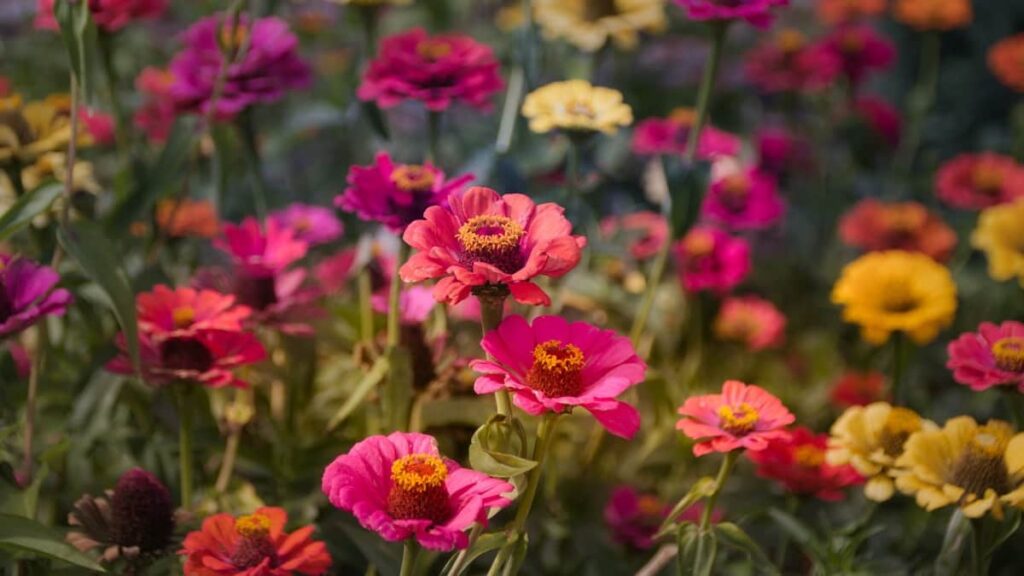
Sunflowers
Sunflower seeds are a popular choice for growing cut flowers. They are easy to grow and produce beautiful, vibrant blooms. There are wide varieties of sunflowers, so you can choose the type that best suits your needs. For example, if you want to grow large sunflowers for arrangements, you will need to choose a variety that produces large blooms. To get started, you will need to purchase sunflower seeds from a reputable supplier.
You can find these online or at your local garden center. Once you have your sunflower seeds, you will need to prepare them for planting. This usually involves soaking them in water overnight. Once your seeds are ready, you can plant them in soil that has been amended with compost or fertilizer. You will need to water planted seed regularly and keep an eye on them as they grow. When the blooms open, you can cut them and enjoy their beauty indoors!
Marigolds
If you’re looking for an easy-to-grow flower that will brighten up your garden, look no further than the marigold! Marigolds are one of the best and easiest flowers to grow from seed and come in various colors. Whether you’re looking for a cheerful yellow or a vibrant orange, you’re sure to find a marigold that suits your taste.
In case you missed it: How to Grow Columbine Flowers: A Guide to Propagation, Planting, and Care
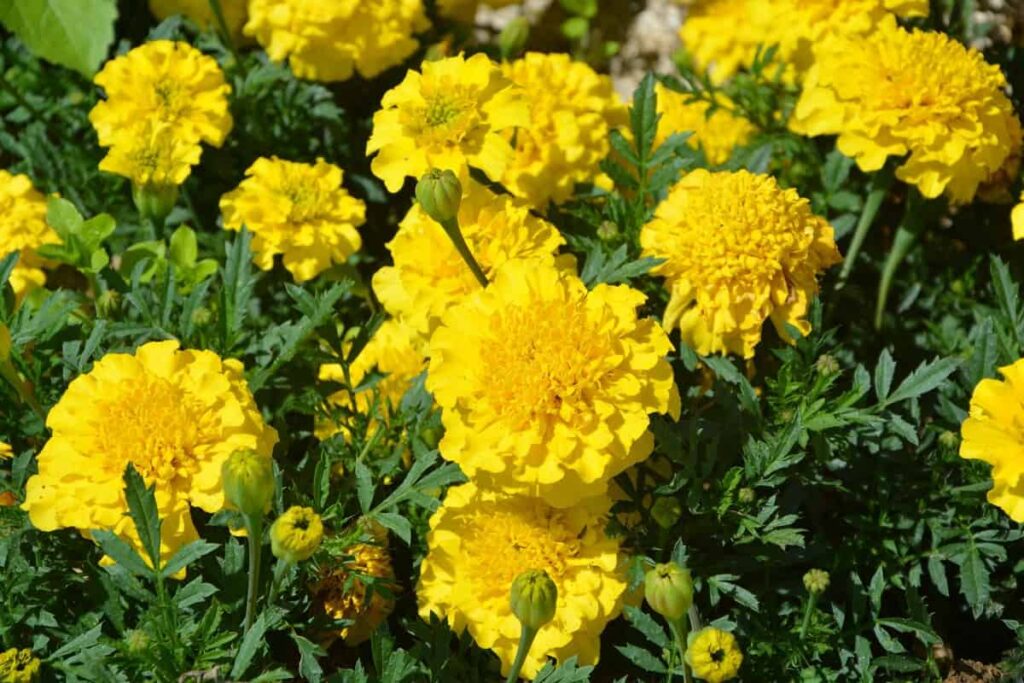
Not only are they easy to grow, but marigolds are also very tolerant of different kinds of soil and climates. They’ll even bloom in partial shade! So whether you’re a beginner gardener or an experienced pro, marigolds are an excellent choice for your garden.
Nasturtiums
Nasturtiums are one of the best and easiest cut flowers to grow from seeds. They are incredibly easy to grow and care for, and they make beautiful cut flowers. Nasturtiums are available in various colors, including red, orange, yellow, and white. They have a long vase life, making great cut flowers for arrangements. Nasturtiums are also very tolerant of hot weather, so they are ideal for summer gardens.
Cosmos
There are a wide variety of flowers that you can easily grow from seeds. Cosmos are one of the best and easiest to grow. They are perfect for beginners as they are very easy to care for and don’t require much attention. Cosmos come in many colors, including white, pink, yellow, and orange. They grow quickly and will bloom from mid-summer to fall. Sowing seeds directly into your garden is a great option, or you can start them indoors 40 to 55 days before the last frost in your area.
To sow the seeds, sprinkle them on the ground and lightly cover them with soil. Water well and keep the area moist until the seeds germinate. Transplant your seedlings when they’ve sprouted. Make sure you thin the plants so they are about 12 inches apart. Cosmos are drought tolerant and don’t need a lot of water once they are established. However, during the blooming period, they will benefit from being watered regularly so that the flowers can stay vibrant and colorful. Deadheading spent blooms will also encourage more flowers to form.
Bachelor buttons
“Bachelor buttons” is one of the best and easiest cut flowers to grow from seeds. They are easy to grow, and they don’t require much care. You can plant Bachelor buttons in the spring or fall, and they will bloom in the summer. They like full sun, but they can also tolerate partial shade. Bachelor buttons are drought-tolerant, so you don’t have to worry about overwatering them. You only need to watch out for snails and slugs, which can damage the leaves.
Daisies
If you want to grow your own daisy cut flowers, it’s actually quite easy to do so from seed. All you need is a sunny spot in your garden and some patience! Here’s a step-by-step guide on how to grow daisy cut flowers from seed:
- Choose a sunny spot in your garden that has well-drained soil.
- Sow the seeds in late spring or early summer, about 1/4 inch deep.
- Keep the soil moist but not wet, and thin the seedlings if necessary.
- When the plants are big enough, transplant them into individual pots or into your garden beds.
- 5. Once they’re established, cut the flowers regularly to encourage more blooming. With just a little bit of care, you can easily grow your own beautiful daisy cut flowers at home!
In case you missed it: How to Grow Rajnigandha (Tuberose): Soil, Propagation, Flowering Season, Planting, and Care
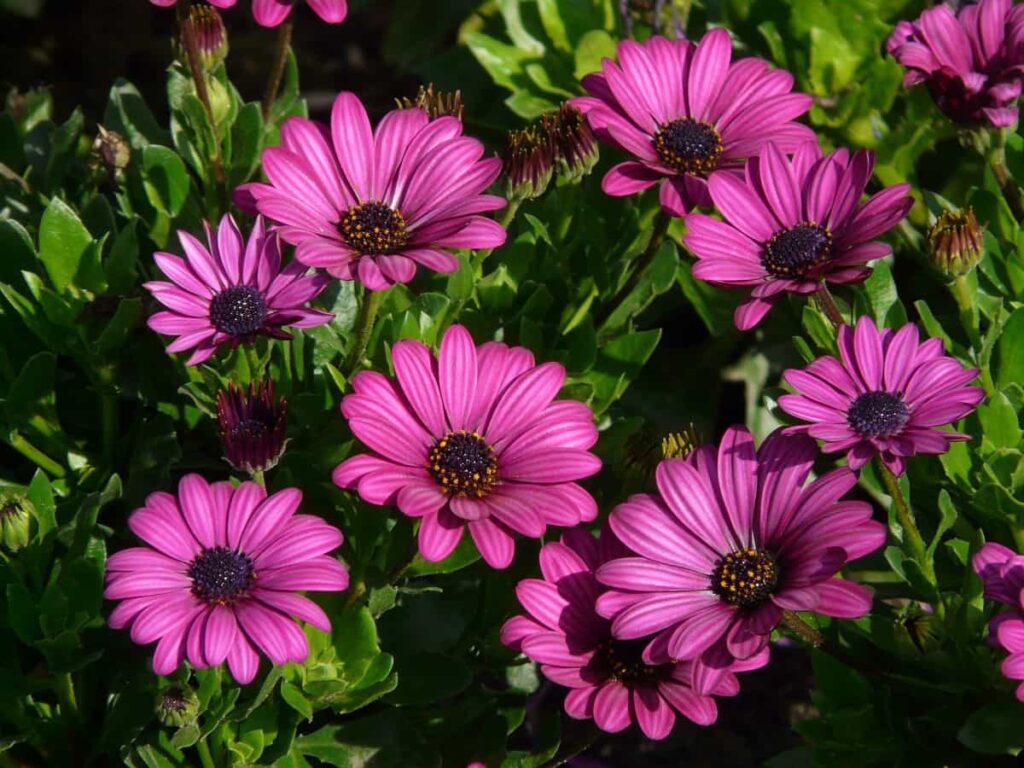
Canterbury bells
Canterbury bells (Campanula medium) are one of the best and easiest cut flowers to grow from seed. They are hardy annuals that will bloom the first year from seed and self-seed readily. The plants grow to about 2 feet tall and have 2 to 3-inch blue or white bell-shaped flowers. Canterbury bells prefer full sun but will tolerate some shade. They prefer well-drained soil but need to be more particular about soil type.
Sow seeds indoors 40 to 55 days before the last frost date or sow directly in the garden after the last frost date. Fill a planting flat or tray with potting mix and sprinkle the seeds on it. Be careful to space them evenly, so they can grow in straight line. It is not advised to cover the seeds, as they need light to germinate. Place the flat in a warm location and keep the soil moist. The seeds should germinate in 10 to 21 days.
Transplant seedlings outdoors after all danger of frost have passed, and they have several sets of true leaves. Space plants 12 inches apart in full sun to partial shade. Water plants regularly during dry weather. After plants are established, cut back flowering stems one-half after blooming to encourage reblooming later in summer.
Calendulas
Calendulas (Calendula officinalis) are one of the best and easiest flowers to grow from seed. They are also known as pot marigolds and have a long blooming season. Calendulas need full sun and well-drained soil. They can be started indoors or outdoors and will self-seed if you let them.
In case you missed it: India Flower Planting Calendar: Month-wise Garden Sowing Chart, Dates Guide for Winter, Summer, and Rainy Season

Morning glories
If you’re looking for a beautiful and easy-to-grow flower, look no further than the morning glory. These beautiful flowers will add a pop of color to any garden and are incredibly easy to grow from seed! Morning glories are fast-growing vines reaching up to 10 feet in length. They produce large, trumpet-shaped flowers in various colors, including white, pink, blue, and purple.
Morning glories prefer full sun and well-drained soil. In an area with hot summers, it’s best to plant morning glories in early spring or late fall. To start your flower seeds, sow them on the surface/top layer of the well-drained soil and keep them moist until they germinate. Once your plants have started to bloom, deadhead the flowers regularly to encourage more blooms. You can also cut morning glory stems to use as cut flowers indoors. You better place the stems in a vase of water and enjoy their beauty all season long!
Love-in-a-mist
Love-in-a-mist is an annual flower that grows easily from seed. The flowers are delicate and lacy and come in various colors, including white, pink, blue, and purple. The foliage is also attractive, with deeply lobed leaves that are sometimes variegated. Love-in-a-mist blooms in late spring or early summer and is often used in cut flower arrangements.
Snapdragons
Snapdragons are one of the best and easiest cut flowers to grow from seeds. They are relatively easy to grow and care for and produce beautiful, colorful flowers that make great cut flowers. Snapdragons are a great choice if you live in a region with little rainfall because they are drought-tolerant.
In case you missed it: How to Make Rose Plants Bushy and Flowers Bigger: Propagation, Fertilizers, Pruning, Planting, and Care
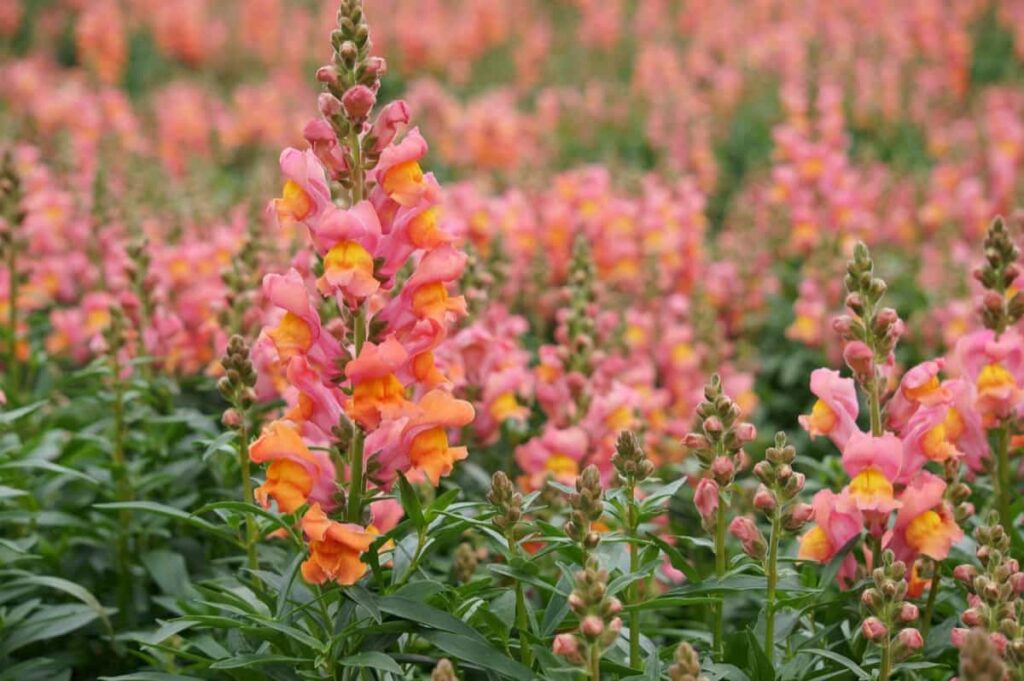
Bleeding hearts
If you’re looking for a romantic gesture or an eye-catching addition to your spring garden, look no further than the bleeding heart. This delicate flower gets its name from its distinctive shape: two heart-shaped petals surround a smaller third petal in the center, suspended from a slender stem. And while they may look fragile, bleeding hearts are quite easy to grow from seed.
Tips for success:
Start with fresh seed. Bleeding heart seeds have a short shelf life, so it’s best to sow them within a year of purchase. Scarify the seeds before planting. This will help improve germination rates by breaking through the hard seed coat. You can do this by sanding the seeds lightly with sandpaper or soaking them in warm water overnight.
Sow the seeds in moistened potting mix or vermiculite and cover with a thin layer of grit or sand. Keep the soil moist and don’t let it get soggy. Place the container in a cool, out-of-the-way place, like a garage or basement. It can take up to four weeks for seeds to germinate.
Once they’ve sprouted, transplant the seedlings into individual pots filled with well-draining potting mix and water regularly. Fertilize monthly with a balanced fertilizer once they start actively growing. In late spring or early summer, you can plant them out in your garden beds after all danger of frost has passed.
Hollyhocks
Hollyhocks are one of the best and easiest cut flowers to grow from seeds. They are tall, a stately flower that adds a touch of elegance to any garden. Hollyhocks come in various colors, including white, pink, purple, and red. Hollyhocks bloom in late spring or early summer and continue until the first frost. To ensure a long blooming season, plant hollyhocks in full sun and keep them well-watered.
In case you missed it: How to Propagate Peace Lily: Flowering Stages, Planting, Growing, and Care for Indoors and Outdoors
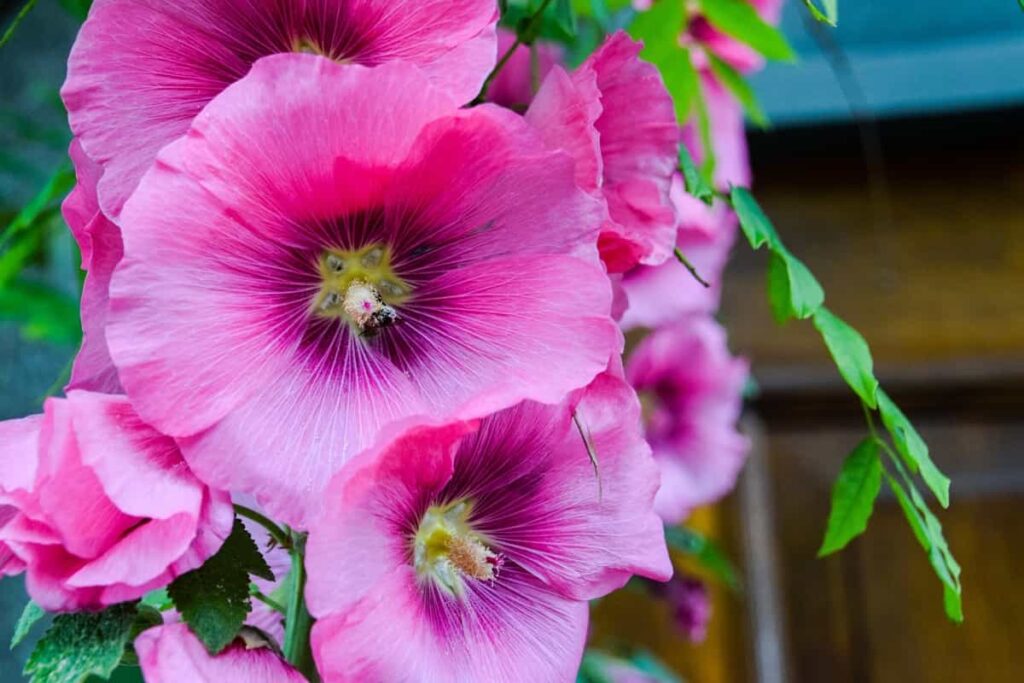
Larkspurs
If you’re looking for a beautiful and easy-to-grow flower, look no further than the larkspur! These lovely blooms come in various colors, including blue, purple, pink, and white. They’re perfect for adding a pop of color to your garden or bouquet. Best of all, they’re relatively easy to grow from seed.
Tips for growing larkspurs
- It’s best to start larkspur seeds indoors about 40 to 55 days before the last frost date in your area.
- Sow seeds on the surface of moistened potting mix or soil. Lightly press them into the soil, but only cover the larkspur seeds with a thin layer of soil, or they may not germinate.
- Keep the planting medium moist but not soggy. Water from below, if possible, to avoid disturbing the delicate seedlings.
- Once seedlings emerge, provide them with plenty of light (a south-facing window is ideal). If they start to stretch or lean towards the light source, rotate the pots, so they grow evenly.
- Larkspur seedlings should be transplanted outdoors after the danger of frost and they have at least two sets of true leaves. Choose a sunny spot with well-drained soil for the best results. With a bit of cayou’llu’ll soon enjoy beautiful blooms from your larkspur plants!
Conclusion
If you want an easy and best way to add color to your garden, consider growing flowers from seed. There are a variety of beautiful and easy-to-grow flowers that you can start from seed, we’vee’ve compiled a list of our favorites. Hope this information is helpful in getting started with your cut flower garden.
- How to Raise Pigs in Your Own Backyard: A Comprehensive Guide
- Budget Friendly Sheep Shed Ideas: Cheap and Low-Cost Tips
- How Much Do Cattle Farmers Make: Revenue Streams in Cattle Farming
- Management Pests and Diseases in Your Cotton Field
- Sheep Farming Business Plan for Beginners
- Aquaponic Farming at Home: A Step-By-Step Guide
- Profitable Village Farming Business Ideas in 2024
- High-Yield Aquaculture: Fast-Growing Fish for Farming
- Effective Fish Pond Construction Techniques for Beginners
- Irrigation and Water Management in Pineapple Farming
- Blossom to Harvest: Mastering Flowering and Pollination in Papaya Farming
- Pig Fattening Essentials: From Selection to Sale for Beginners
- Raising Wagyu Cattle: A Complete Guide for Premium Beef Production
- Soil Types and Their Water Holding Capacity
- Optimizing Irrigation Schedules for Coconut Groves for Enhanced Yield
- Espresso Your Garden: Coffee Grounds for Healthier Acid-Loving Plants
- The Best Soil Mix for Snake Plants: How to Mix Your Own Snake Plant Soil
- Green Thumb Success: Expert Tips for Cultivating Greenhouse Beans All Year Round
- Bloom All Year Round: The Ultimate Guide to Indoor Hyacinth Care
- Eco-Friendly Gardening: How to Make Liquid Fertilizer from Kitchen Waste
- Ultimate Guide to Grow Anise in Pots: Explore Seed Propagation to Harvesting
- Guide to Raising Chester White Pigs: Discover Breed Facts to Growth Management
- Mastering the Elegance: The Ultimate Guide to Weeping Cherry Tree Care, Planting, and Maintenance
- Ultimate Guide to Planting Garlic in Grow Bags: Growing Strategies for Beginners
- How to Fix Spider Plant Leaf-Related Problems: Natural and Organic Remedies
- 10 Reasons Why Your Tulsi Plant is Shedding Leaves: Home Remedies and Solutions
- Optimizing Growth and Yield: The Advantages of Palm Bunch Ash Fertilizer
- Utilizing Neem Oil Extract as a Natural Pesticide for Hydrangea
- From Soil to Harvest: Various Ways in Which Farmers Can Use AI Tools
- Steps to Encourage and Induce Citrus Flowers: A Comprehensive Guide
- How to Fix Snake Plant Leaf-Related Issues: Natural and Organic Remedies
- Transform Your Garden into a Fragrant Oasis with Raat Ki Rani (Night Blooming Jasmine)
- Discover the Ideal Chicken Breeds for Philippine Farms
- How to Create a Poultry Egg Farm Business Plan for Profits
- Grow Lemon Cucumbers Like a Pro: Insider Techniques for Bountiful Yields
- Ultimate Guide to Caring for Your Pink Princess Philodendron: Tips for Thriving Variegation
